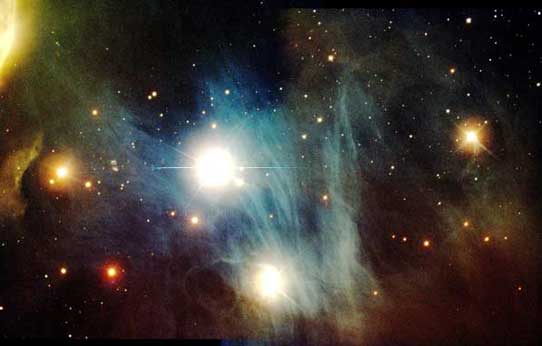Astronomers Study T-Tauri Stars in the Chamaeleon Star-Forming Region
 June 11: New research on young (T-Tauri) stars in the Chamaeleon and Rho Ophiuchus star-forming regions has determined their ages as being between about five – six million years old, as well as determining other properties.
June 11: New research on young (T-Tauri) stars in the Chamaeleon and Rho Ophiuchus star-forming regions has determined their ages as being between about five – six million years old, as well as determining other properties.
A newborn star typically goes through four stages of adolescence. It begins life as a protostar still enshrouded in its natal molecular cloud, accreting new material and developing a proto-planetary disc. Slowly, stellar winds and radiation blow away the surrounding shell of gas and dust, and the third stage, when the surrounding envelope has cleared, is called the T-Tauri phase. T-Tauri stars (the class is named after the first star of this type that was so identified) are less than about ten million years old, and provide astronomers with promising candidates in which to study the early lives of stars and planets. They were among the first young stars to be identified because the earlier stages, still embedded in their birth clouds, were blocked from optical observations by the dust. In the fourth stage, the disk stops accreting and the source’s radiation comes from the star’s photosphere. T-Tauri stars produce strong X-rays, primarily by what is thought to be coronal activity much like the coronal activity in our own Sun, although in some cases a component might be coming from hot material in the dusty disk.
Measurements of T-Tauri circumstellar disks provide important tests for theories of planet formation and migration. Near-infrared results, for example, sample the hotter temperature dust grains, and can reveal the presence of gaps in the disk (perhaps cleared by massive planets) when an expected ring of warm dust around the star is not detected. Astronomers during the past few decades have been able to use infrared space telescopes like Spitzer to probe T-Tauri disks, but there are still many puzzles, in particular about the mechanisms responsible for the accretion, the subsequent dissipation of material, and the evolutionary ages when these processes occur.
CfA astronomer Philip Cargile was a member of a team of seven scientists studying the evolution of these stars and their disks. They took detailed optical observations (including spectra) of a sample of twenty-five X-ray selected T-Tauri stars in two nearby star-forming clouds to derive their ages and stellar masses. They find that most of the sources in one cloud are between about five and six million year old; a couple turn out to be more like twenty-five million years old and can now be excluded from the T-Tauri class. In the other cloud, most of the sources are younger than about ten million years. The results agree well with theoretical models and other observations. Perhaps more usefully, the results help to identify true T-Tauri stars with disks that would be suitable for imaging observations with a new generation of large telescopes.
Source: Harvard-Smithsonian Center for Astrophysics
